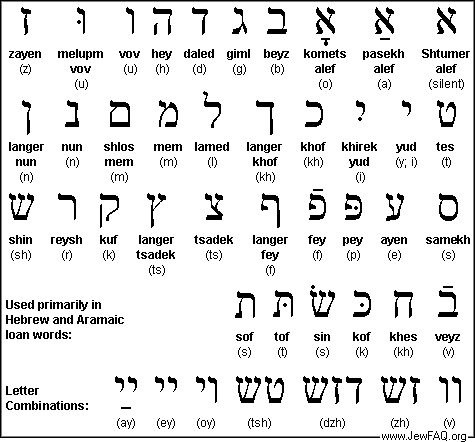What is Yiddish?
Origins & History
It is believed that Yiddish originated in the 10th century when Jews from France and Northern Italy began migrating and establishing large communities in Germany for the first time. Previously there had been amall communities that primarily spoke German, but the new influx of residents along the Rhine river spoke a Jewish-French dialect known as Laaz. Not only did the new arrivals toss in Laaz expressions and words into their German speech but the isolation of Jewish communities during the Crusades both contributed to the shift from German to a modified, more Jewish form.
In the thirteenth century the Jewish populations migrated to escape persecution and introduced Yiddish for the first time to eastern Germany, Poland, and other eastern European territories. Through exposing Yiddish to the Slavic languages of the east Yiddish shifted from being a Germanic dialect to becoming a separate language. As a result a division between the eastern Yiddish of the Jews in Slavic lands, and the western Yiddish of the Jews remaining in France and Germany, began to develop.
By the sixteenth century, Yiddish became a written language in addition to a spoken one, with greater Slavic influence as Jews became a stronger presence in Poland. After the late seventeenth century western Yiddish began to decline as the eastern dialect became the more important and widely spoken one. This was partially due to the Jewish Enlightenment in western Europe, and the flourishing of Yiddish culture in eastern Europe. Yiddish’s usage was dealt an abrupt blow in the mid-twentieth century due to the Holocaust and the repression of Soviet Jews under Stalin, forcing both strains into decline.
Structure
The basic grammar and vocabulary of Yiddish is Germanic but it is written in the Hebrew alphabet.
However it is not a dialect of German or Hebrew but an entirely separate language part of a family Western Germanic languages, similar to the English language. Often times the relationship between Hebrew and Yiddish is compared to that of Chinese and Japanese–although some aspects of the writing system are the same and some words were adopted they are entirely separate languages. Even if a word in German sounds like one in Yiddish it is not uncommon for the meanings to be completely different!

Yiddish language alphabet. Note the differences between this and the diagram displaying the Hebrew alphabet
The Yiddish language and Hebrew are different and multiple ways and the difference in alphabets reflects this. Yiddish adds diacritics (an accent on a letter that denotes a difference in pronunciation from when the letter is unmarked) and combines some of the letters found in the Hebrew alphabet to better illustrate speech sounds in the language. The two languages are similar in that both are spoken and written primarily by Jews, they share the same alphabet, are read from right to left, do not use capital letters, and some Yiddish words are borrowed from Hebrew (although their Romanized transcriptions may differ in order to display differences in pronunciation.)
However there are significant differences between the two languages. This can be attributed to the fact Yiddish is a “fusion language” incorporating elements from Hebrew, Aramaic, Old Italian, Old French, Czech, Polish, Ukrainian, and Russian whereas Hebrew is mostly the product of Semitic influence.
And, as noted previously, due to Jewish migration from Germany into Eastern parts of Europe where Slavic languages reigned, Yiddish developed from being a German dialect into a language of its own.
Yiddish Influence on American Vernacular
Due to Jewish integration into American society many terms and phrases have been adopted from the Yiddish language and have common use today.
- Mishmash
- Schmooze
- Icky
- Nudge
- Fressing
- Handl
Yiddish Today
The death of six million Jews at the hands of the Holocaust caused the majority of the world’s Yiddish speakers to be wiped out. The surviving Yiddish speakers often migrated elsewhere and made Yiddish their second tongue at best. Those who lived in the Soviet Union were even further limited with the outlawing of the language under Stalin.
Despite these major obstacles and predictions of extinction Yiddish has been revitalized. Numerous populations use it as their main language including the generation that lived during and immediately after the Holocaust, and the ultra-Orthodox communities living in New York and parts of Israel. Yiddish is also being acknowledged as a real language by academics, and not as the “corrupted tongue” that it was considered throughout history. Universities throughout the world now offer courses and even degree programs in Yiddish linguistics and literature and there are programs to teach young and old alike. Klezmer music and the translation of popular songs and books also keeps the language alive.



